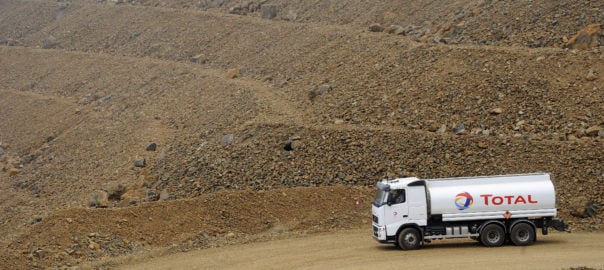21/06/2019 News
Total on the benefits of fuel-efficient lubricants

In a previous Total Mining Solutions article titled Five ways to reduce fuel costs at a mine, it was identified that the move to lighter viscosity engine oils provided less friction under hydrodynamic lubrication conditions within the engine, resulting in fuel savings.
To clarify this in more detail, it is important to understand the most important physical property of a lubricant: viscosity.
Kinematic viscosity is defined as the fluid’s resistance to flow under gravity at a certain temperature. There is a second measure of viscosity known as dynamic or absolute viscosity. This is defined as the tangential force per unit area required to move a horizontal plane with respect to another plane at a unit speed, or in short, a measure of the fluid’s internal resistance to shear.
Besides the use of friction modifiers (FM) acting only in thin-film lubricating conditions (cam shaft/valve train), the main way to reduce fuel consumption without compromising durability is to utilise lower viscosity grade oils with sufficient high-temperature/high-shear-rate (HTHS) parameters.
For heavy-duty diesel engine oils, a minimum requirement setting of 3.5 cP (HTHS viscosity at 150°C temperature and one million reciprocal seconds shear rate to simulate viscosity in bearings) is currently required to be passed as a suitable diesel engine lubricant. This means that at operating temperatures and shear rate, the viscosity of the oil will remain stable whilst still providing the desired film thickness to prevent metal-on-metal contact.
Total Lubricants was among the first to introduce fuel-economy or fuel-efficient (FE) lubricants. The journey started with passenger vehicles in 1993 with technology improvements being applied to lubricants for Transport (1997) and Mining lubricants(2007).
Total also developed its own in-house testing methodology in order to verify fuel economy results of Total’s fuel efficient lubricants. Today, there are standardised international procedures such as the Globally Harmonised Worldwide Heavy Duty Transient Cycle (WHTC) for both hot and cold start requirements; as well as the Worldwide Heavy Duty Steady-state Cycle (WHSC) in order to verify fuel economy performances.
Targeting the mining industry with the proven concept
In its history of FE lubricant development, Total analysed substantial data in on-road and off-road application tests resulting in extensive knowledge being gained around wear control on ultra-low viscosity lubricants (HTHS of 2.9 cP and lower). This has resulted in Total being able to formulate FE lubricants with equivalent oil film thickness independent (to some extent) of the HTHS values.
This knowledge, combined with base oil and additive technology has led to Total’s launch of the Total Rubia Works 4000 FE 10W-30 (API CK-4), especially designed for the mining industry but also with application in the transport industry too.
These lubricants have passed stringent performance requirements, such as Caterpillar CAT ECF-3, Cummins CES 20086 and JASO DH-2 for Japanese engines like Komatsu. In addition, independent bench testing on Total Rubia Works 4000 FE SAE 10W-30 using an off-road machine has indicated fuel economy savings of 1.89 per cent with excellent repeatability of test results. This figure is proven by the fuel economy certificate issued by Danielson Services Laboratory in France.
Achieving significant amounts in savings
To help identify economical savings associated with the use of Total Rubia Works 4000 FE SAE 10W-30, the following is provided in a simple business case scenario:
- Caterpillar 793F Haul Truck operates 290 days/year, 24 hours a day
- Diesel fuel consumption of the vehicle during operation averages at 150 litres / hour
This equates to the Haul truck consuming 1,044,000 litres of fuel per annum. Independent bench testing has identified a 1.89 per cent fuel economy improvement from the use of the Total Rubia Works 4000 FE SAE 10W-30. In the above example, this translates to a fuel reduction of 19,731 litres per annum. Depending on the number of equivalent equipment within a fleet, significant savings in the total cost of operation (TCO) per annum can be realised through reduced fuel consumption.
Total’s range of FE lubricants play an essential role in reducing the operational fuel costs of mining companies by utilising specific viscosity grades and specially enhanced additives designed to minimise the friction responsible for 10-15 per cent of energy loss within an engine and drive train compartments. Total’s success in the development of FE lubricants has resulted in Total lubricants being utilised as first fill lubricants for a number of OEM commercial vehicles, and makes Total the mining lubricant supplier of choice.

